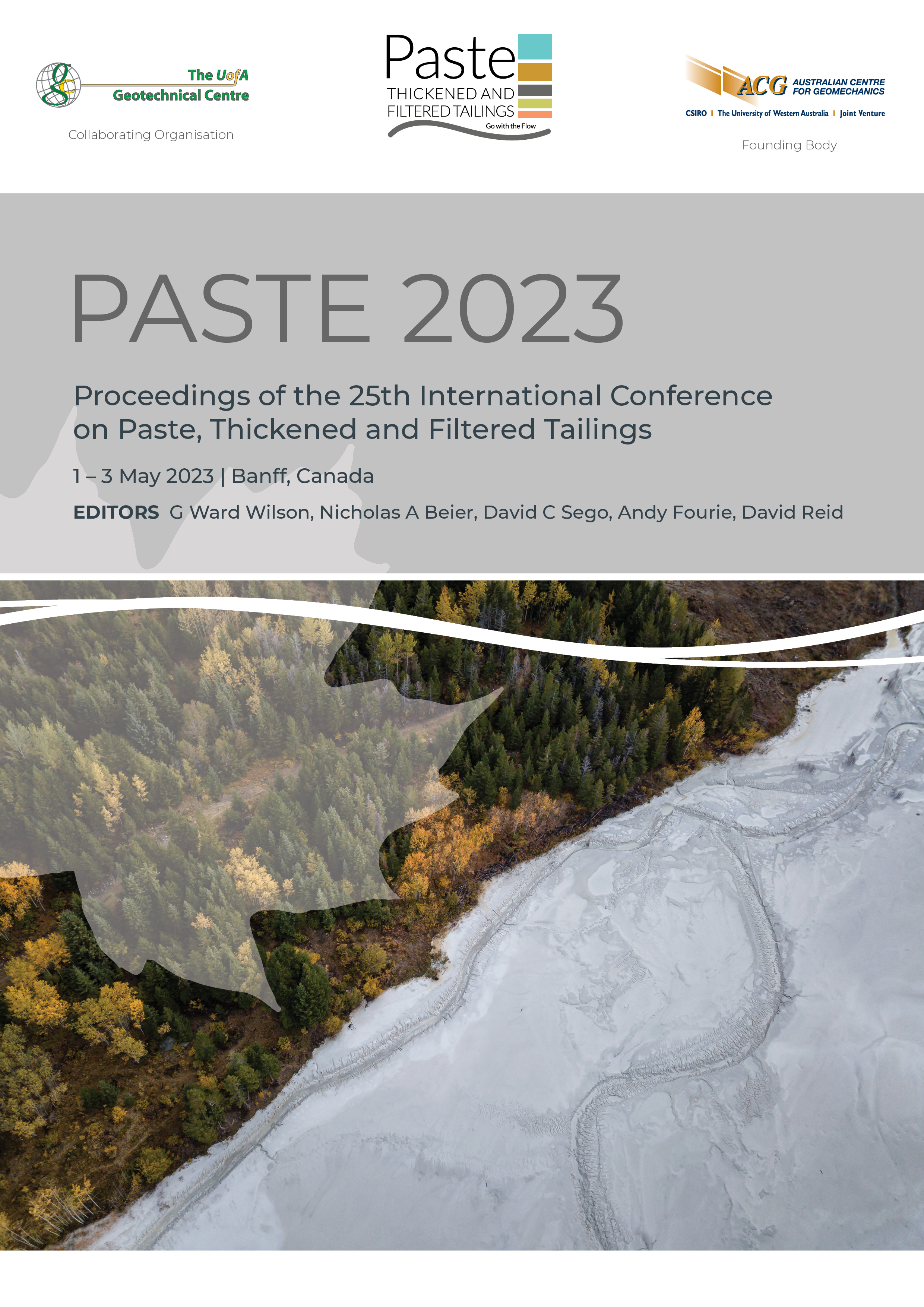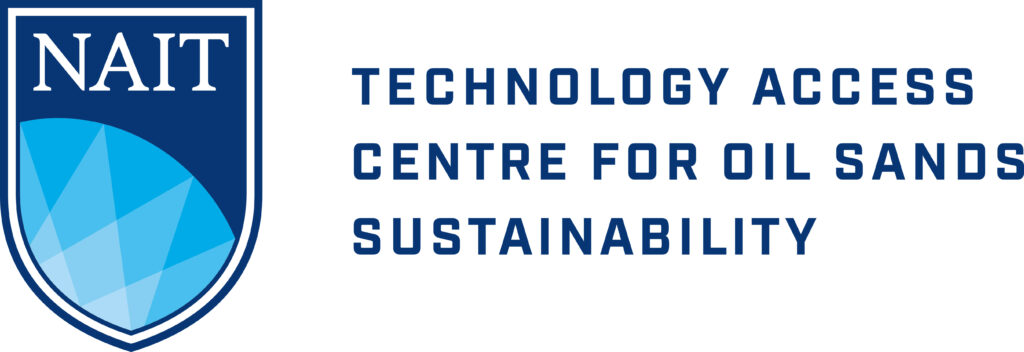An alternative to NaOH in the alkali-activation of ground granulated blast furnace slag in the formulation of cemented paste backfills

|
Authors: Ouffa, N; Benzaazoua, M; Belem, T; Trauchessec, R; Lecomte, A |
DOI https://doi.org/10.36487/ACG_repo/2355_08
Cite As:
Ouffa, N, Benzaazoua, M, Belem, T, Trauchessec, R & Lecomte, A 2023, 'An alternative to NaOH in the alkali-activation of ground granulated blast furnace slag in the formulation of cemented paste backfills', in GW Wilson, NA Beier, DC Sego, AB Fourie & D Reid (eds), Paste 2023: Proceedings of the 25th International Conference on Paste, Thickened and Filtered Tailings, Australian Centre for Geomechanics, Perth, pp. 112-126, https://doi.org/10.36487/ACG_repo/2355_08
Abstract:
In the mining district of the Abitibi region (Canada), several underground mines use cemented paste backfill (CPB) for ground support. The binder typically used is a blend of 20% general use Portland cement (GU) and 80% ground granulated blast furnace slag (GGBFS), and qualified as the reference binder (RB). Using the RB always allows CPB to achieve the unconfined compressive strengths (UCSs) targets required. Due to its relatively high price, limited GGBFS availability and the high carbon footprint attributable to GU manufacturing, the search for alternative binders becomes imperative. Alkali-activated binders (AABs) made of GGBFS, and type F fly ash (FAF) activated using NaOH, were tested at the laboratory scale. This activation process achieved similar UCSs of CPB prepared with the RB. Unfortunately, the economic and environmental assessment of these AABs suffers from the high costs of NaOH, its high carbon footprint and GGBFS dosage, which is still significant. Consequently, the industrial application of these AABs in mine backfilling becomes challenging. The proposed alternative to NaOH consists of using circulating dry scrubber dusts (CDSD) from the desulfurisation process of Rio Tinto Iron and Titanium operations at Sorel-Tracy (Quebec, Canada). This byproduct was successfully tested in a CPB formulation. Moreover, FAF and fine glass powder (FGP) are proposed as partial replacement to GGBFS. The results show that at 28 days the UCS values of CPB prepared with the GGBFS/CDSD mixtures are comparable to the ones of the RB. At 7 days, satisfactory UCS are obtained and can reach the same UCS of the CPB prepared with the RB by adding only 5% clinker to the GGBFS/CDSD mixture. In addition, several mixtures have shown comparable and even higher UCSs to the RB with lower costs and smaller carbon footprints (CO2eq). The results are promising and encouraging for a future industrial application.
Keywords: cemented paste backfill, NaOH, alkali-activated binders, circulating dry scrubber dusts, binder cost, carbon footprint
References:
Adesanya, E, Ohenoja, K, Di Maria, A, Kinnunen, P, & Illikainen, M 2020, ‘Alternative alkali-activator from steel-making waste for onepart alkali-activated slag’, Journal of Cleaner Production, vol. 274,
Andrew, RM 2018, ‘Global CO 2 emissions from cement production’, Earth System Science Data, vol. 10, no. 1, p. 195.
Belem, T 2017, Mining Backfill Courses.
Belem, T, & Benzaazoua, M 2003, ‘Utlisation du remblai en pâte comme support de terrain. Partie I : de sa fabrication à sa mise en place sous terre’, Après-mine 2003.
Belem, T, & Benzaazoua, M 2008, ‘Design and application of underground mine paste backfill technology’, Geotechnical and Geological Engineering, vol. 26, no. 2, pp. 147–174.
Belem, T, Peyronnard, O, & Benzaazoua, M 2010, ‘A model of formulation of blended binders for use in cemented mine backfills’, Proceedings of the First International Seminar on the Reduction of Risk in the Management of Tailings and Mine Waste.
Benzaazoua, M, Fall, M, & Belem, T 2004a, ‘A contribution to understanding the hardening process of cemented pastefill’, Minerals Engineering, vol. 17, no. 2, pp. 141–152,
Benzaazoua, M, Marion, P, Picquet, I, & Bussière, B 2004b, ‘The use of pastefill as a solidification and stabilization process for the control of acid mine drainage’, Minerals Engineering, vol. 17, no. 2, pp. 233–243,
j.mineng.2003.10.027
Benzaazoua, M, Ouellet, J, Servant, S, Newman, P, & Verburg, R 1999, ‘Cementitious backfill with high sulfur content Physical, chemical, and mineralogical characterization’, Cement and Concrete Research, vol. 29, no. 5, pp. 719–725,
Benzaazoua, M, Peyronnard, O, Belem, T, Fried, E, Stephant, A & Dublet, G 2010, ‘Key issues related to behaviour of binders in cemented paste backfilling’, in R Jewell & AB Fourie (eds), Paste 2010: Proceedings of the Thirteenth International Seminar on Paste and Thickened Tailings, Australian Centre for Geomechanics, Perth, pp. 345–363,
Bowker, LN, & Chambers, DM 2015, ‘The risk, public liability, & economics of tailings storage facility failures’, Earthwork Act, vol. 24, pp. 1–56.
Chekireb, S 2015, ‘Valorisation de la poudre de verre dans le béton autoplaçant’, master’s thesis, Sherbrooke University, Sherbrooke.
Chen, C, Habert, G, Bouzidi, Y & Jullien, A 2010a, ‘Environmental impact of cement production: detail of the different processes and cement plant variability evaluation’, Journal of Cleaner Production, vol. 18, no. 5, pp. 478–485,
Chen, C, Habert, G, Bouzidi, Y, Jullien, A, & Ventura, A 2010b, ‘LCA allocation procedure used as an incitative method for waste recycling: An application to mineral additions in concrete’, Resources, Conservation and Recycling, vol. 54, no. 12,
Cornell, JA 2002, ‘Experiments with mixtures: designs, models, and the analysis of mixture data’, John Wiley & Sons.
Davidovits, J 1991, ‘Geopolymers: inorganic polymeric new materials’, Journal of Thermal Analysis and Calorimetry, vol. 37, no. 8,
pp. 1633–1656.
Falayi, T, Ntuli, F, & Okonta, F 2018, ‘Synthesis of a paste backfill geopolymer using pure acidic gold mine tailings’, The Journal of Solid Waste Technology and Management, vol. 44, no. 4, pp. 311–320.
Fernández-Jiménez, A, & Palomo, A 2003, ‘Characterisation of fly ashes, Potential reactivity as alkaline cements’, Fuel, vol. 82, no. 18, pp. 2259-2265,
Galos, KA, Smakowski, TS & Szlugaj, J 2003, ‘Flue-gas desulphurisation products from Polish coal-fired power-plants’, Applied Energy, vol. 75, no. 3, pp. 257–265,
Gauthier, P 2004, Valorisation des Liants et des Rejets Industriels dans les Remblais Miniers, DESS thesis, Université du Québec en Abitbi-Témiscamingue, Rouyn-Noranda.
Grice, T 1998, ‘Underground mining with backfill’, 2nd Annual Summit – Mine Tailings Disposal Systems, pp. 1–14.
Kiventerä, J, Golek, L, Yliniemi, J, Ferreira, V, Deja, J & Illikainen, M 2016, ‘Utilization of sulphidic tailings from gold mine as a raw material in geopolymerization’, International Journal of Mineral Processing, vol. 149, pp. 104–110, :
Li, J, Zhang, S, Wang, Q, Ni, W, Li, K, Fu, P, Hu, W & Li, Z 2020, ‘Feasibility of using fly ash–slag-based binder for mine backfilling and its associated leaching risks’, Journal of Hazardous Materials, vol. 400,
Matthes, W, Vollpracht, A, Villagrán, Y, Kamali-Bernard, S, Hooton, D, Gruyaert, E, Marios, S & De Belie, N 2018, ‘Ground granulated blast-furnace slag’, in N De Belie, M Soutsos & E Gruyaert (eds), Properties of Fresh and Hardened Concrete Containing Supplementary Cementitious Materials: State-of-the-Art Report of the RILEM Technical Committee 238-SCM, Springer International Publishing, Cham, pp. 1–53.
Neathery, JK 1996, ‘Model for flue‐gas desulfurization in a circulating dry scrubber’, AIChE Journal, vol. 42, no. 1, pp. 259–268.
Ouffa, N 2019, ‘Solubilité de différents minéraux aluminosilicatés en vue de leur contribution à la géopolymérisation dans les remblais miniers en pâte’, Mémoire de Maîtrise, Univeristé du Québec en Abitibi-Témiscamingue, Quebec,
Ouffa, N, Benzaazoua, M, Belem, T, Trauchessec, R & Lecomte, A 2020, ‘Alkaline dissolution potential of aluminosilicate minerals for the geosynthesis of mine paste backfill’, Materials Today Communications, vol. 24,
Ouffa, N, Trauchessec, R, Benzaazoua, M, Lecomte, A & Belem, T 2022, ‘A methodological approach applied to elaborate alkali-activated binders for mine paste backfills’, Cement and Concrete Composites, vol. 127,
Peyronnard, O & Benzaazoua, M 2011, ‘Estimation of the cementitious properties of various industrial by-products for applications requiring low mechanical strength’, Resources, Conservation and Recycling, vol. 56, no. 1, pp. 22–33,
Peyronnard, O & Benzaazoua, M 2012, ‘Alternative byproduct based binders for cemented mine backfill: Recipes optimisation using Taguchi method’, Minerals Engineering, 29, 28-38.
Sahi, A, Belem, T, & Benzaazoua, M 2015, ‘Mise en évidence expérimentale du dosage optimal des ciments composés (liants) utilisés dans la fabrication des remblais en pâte cimentés’, Proceedings of the 68th Canadian Geotechnical Conference.
Scrivener, K, Martirena, F, Bishnoi, S & Maity, S 2018, ‘Calcined clay limestone cements (LC3)’, Cement and Concrete Research, vol. 114, pp. 49–56.
Simate, GS & Ndlovu, S 2014, ‘Acid mine drainage: Challenges and opportunities’, Journal of Environmental Chemical Engineering, vol. 2, no. 3, pp. 1785–1803,
Soliman, NA & Tagnit-Hamou, A 2016, ‘Development of ultra-high-performance concrete using glass powder – Towards ecofriendly concrete’, Construction and Building Materials, vol. 125, pp. 600–612,
Zidol, A 2009, Optimisation de la Finesse de la Poudre de Verre dans les Systèmes Cimentaires Binaires, master’s thesis, Sherbrooke University, Sherbrooke.
© Copyright 2026, Australian Centre for Geomechanics (ACG), The University of Western Australia. All rights reserved.
View copyright/legal information
Please direct any queries or error reports to repository-acg@uwa.edu.au
View copyright/legal information
Please direct any queries or error reports to repository-acg@uwa.edu.au



